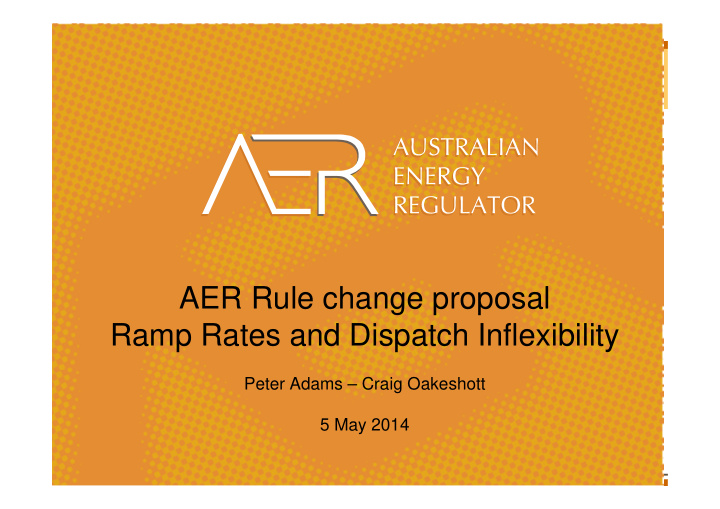



AER Rule change proposal Ramp Rates and Dispatch Inflexibility Peter Adams – Craig Oakeshott 5 May 2014
Background to the rule change proposal Peter Adams Acting General Manager Wholesale Markets
2009 Rule Change • AEMC’s final decision on Ramp Rates, Market Ancillary Service Offers, and Dispatch Inflexibility (AER proponent) published Jan 2009 • In part, proposed to assist congestion/system security due to low (0 and 1 MW) ramp rates • Outcomes: – RRs are technical: “The Rule would require that the technical parameters in relation to ramp rates, market ancillary service offers and dispatch inflexibility reflect technical capability of plant.” – Bid RRs > 3MW/min or 3% unless technical reason – AEMC considered congestion not a significant issue at the time, but flagged further work
Tackling congestion • TFR recommended raft of initiatives – OFA model - long term solution • AER supports TFR process • AER committed to exploring ways to minimise symptoms of congestion (disorderly bidding) • Technical Parameters not addressing problem (but some symptoms)
This Rule Change Proposal • Rule change clarifies application of these technical parameters – beyond congestion • Technical parameters are consistent with their intended (technical) purpose • Consistency between rules and treatment of these parameters in the dispatch process
Application of the proposed Rule Craig Oakeshott Director Wholesale Energy Markets
Application of the rule change • Intention is: – Apply technical rules to technical parameters – not to compromise plant safety or increase costs – rather to avoid having parameters changed for non plant reasons to maximise a financial position – Reasonable assessment approach
Application of the rule change • Technical reasons already required (<3MW/min) • Consistent application across all units • Technical practicalities – Ramp rates vary across operating ranges • Plant conditions (firing configurations and change overs, equipment outages or limits) • Head limits / water availability / bank saturation • Short term capability may be different to sustained rates – Inflexibility profiles • Plant residual heat, fuel availability, state of synchronisation
Information provision • Bids apply across many time frames – Should reflect best estimate of capability based on reasonable assumptions of conditions at the time – 36 hours out many things are uncertain – offer reflects reasonable estimate of the plant conditions that would apply later – Closer to dispatch, better information - refine the offer
Information provision • Not expecting high resolution calculation to accommodate every operational circumstance • Won’t examine small differences • Will examine deviations from expected levels where market conditions create incentives • SCADA – Not recognised in rules – NEMDE uses most limiting of offered and SCADA – Guideline requires bid to match SCADA
Other issues • NEMDE – FSIP and RRs – Potentially powerful commercial tools • effectively can’t be breached • both have CVP values greater than 1100 – >30 x Secure Network Limits (CVP =35) – >3 x Satisfactory Network limits (CVP =360) – impacts • short term – NEMDE will solve - it violates other constraints • long term – constraints become more conservative • Network planning – Since 2009 – STPIS Incentive on NSPs • Market Impact Component • dramatically improved over the last 5 years
Recommend
More recommend